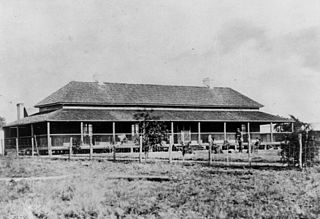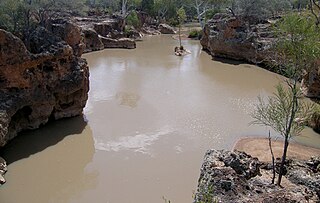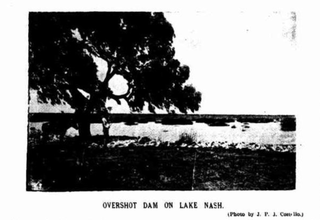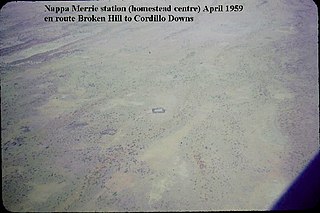Keeroongooloo, previously known as Keerongooloo or Keerongoola is a pastoral lease that operates as a cattle station in the Channel Country of South West Queensland, Australia.
Keeroongooloo, previously known as Keerongooloo or Keerongoola is a pastoral lease that operates as a cattle station in the Channel Country of South West Queensland, Australia.
The property occupies an area of 5,814 square kilometres (2,245 sq mi) along Cooper Creek and is able to carry a herd of approximately 15,000 cattle. It is currently owned by the Georgina Pastoral Company, a subsidiary of the Hughes Pastoral Group run by Peter Hughes and his family. [1]
For thousands of years the area was part of the land of the Bidia people. [2] In the late 1860s, British pastoralist John Costello laid claim to the area which became known as the Keeroongooloo pastoral station. Costello offered up part of his lease to his cook and associate James Scanlan who named that part Springfield. [3] Keeroongooloo itself was initially stocked by John Bligh Nutting and Robert Doyle in 1871. Nutting was an ex-Native Police officer, and after a skirmish with the Bidia people over the killing of cattle, his stockmen cleared the "niggers" (which they referred to the Bidia as) off Keeroongooloo by shooting at them. The Aboriginal population on Keeroongooloo at the time of British colonisation was estimated to be in the hundreds. [4]
Another part of the lease, which was known as Wombinderry, was taken up by Alexander Reid of A. Reid and Company in 1871. [3] Reid established a horse breeding enterprise at Wombinderry (also known as Wombundarry waterhole) and in early 1872, one of his stockmen named Maloney was killed by Bidia people for shooting at them and killing their dogs. Native Police troopers under Sub-Inspector James Gilmour from the Thargomindah barracks were sent out along Cooper's Creek and massacred a group of Aboriginal people in retribution. [3] [5] [6]
From the 1870s up until the present-day management of the Hughes family, Keeroongooloo has had a range of owners such as John Hope, Vincent James Dowling, G. Scarfe, the Queensland Government, the Birt family and the Australian Pastoral Company.
In 1988, Slim Dusty released a song entitled Keeroongooloo Station on his Cattlemen from the High Plains album. [7]

In Australia, a station is a large landholding used for producing livestock, predominantly cattle or sheep, that needs an extensive range of grazing land. The owner of a station is called a pastoralist or a grazier, corresponding to the North American term "rancher".

In Australia and New Zealand, a cattle station is a large farm, the main activity of which is the rearing of cattle. The owner of a cattle station is called a grazier. The largest cattle station in the world is Anna Creek Station in South Australia, which covers an area of 23,677 square kilometres.

A drover in Australia is a person, typically an experienced stockman, who moves livestock, usually sheep, cattle, and horses "on the hoof" over long distances. Reasons for droving may include: delivering animals to a new owner's property, taking animals to market, or moving animals during a drought in search of better feed and/or water or in search of a yard to work on the livestock. The drovers who covered very long distances to open up new country were known as "overlanders".

A stock route, also known as travelling stock route (TSR), is an authorised thoroughfare for the walking of domestic livestock such as sheep or cattle from one location to another in Australia. The stock routes across the country are colloquially known as The Long Paddock or Long Paddock.
The Arnold River is a river in the north of the Northern Territory of Australia.

Aramac Station was a pastoral lease that has operated both as a cattle station and a sheep station. It is located about 83 kilometres (52 mi) south east of Muttaburra and 162 kilometres (101 mi) north west of Alpha near the town of Aramac in Queensland.

Wave Hill Station, most commonly referred to as Wave Hill, is a pastoral lease in the Northern Territory operating as a cattle station. The property is best known as the scene of the Wave Hill walk-off, a strike by Indigenous Australian workers for better pay and conditions, which in turn was an important influence on Aboriginal land rights in Australia.

Yapunyah Waterhole lies in the Mulga Lands bioregion of western Queensland. The waterhole is about two kilometres long and covers approximately 22 hectares when full. It is defined as a permanent waterhole in a region where permanent waterholes are extremely rare and therefore provide important refuges for aquatic plants and animals. These rare waterholes were also vital for Aboriginal people and provided both spiritual and physical nourishment.

South Galway Station and often referred to as South Galway and also once known as Galway Downs is a pastoral lease that operates as a cattle station.

Nappa Merrie Station, most commonly known as Nappa Merrie, is a pastoral lease that operates as a cattle station in central west Queensland, Australia.

Durrie Station is a pastoral lease that operates as a cattle station in Queensland, Australia.
Morney Plains Station, most commonly referred to as Morney Plains, is a pastoral lease that operates as a cattle station in south west Queensland.



The Bidia, also called Biria, are an Aboriginal Australian people of the central west and western regions of the state of Queensland. Their language is known as Pirriya.
The Wulili are an Indigenous Australian people of the state of Queensland.